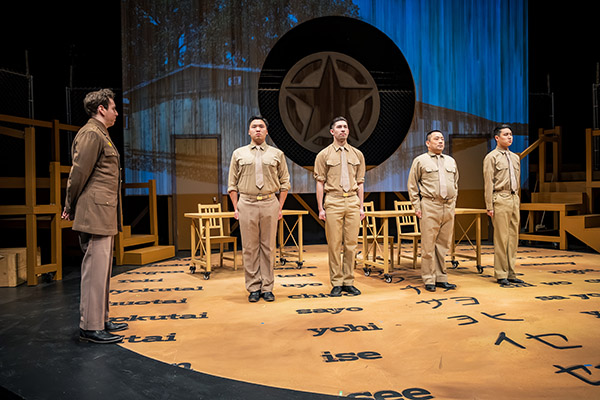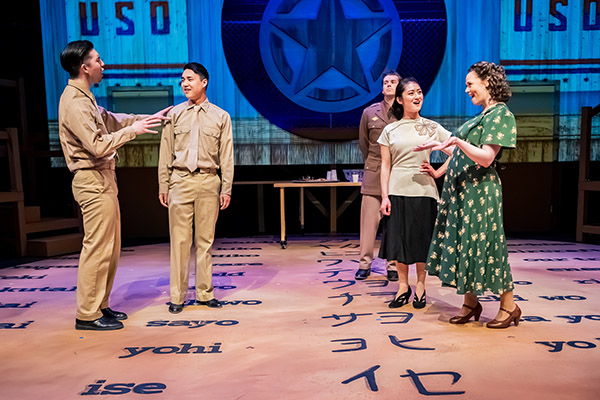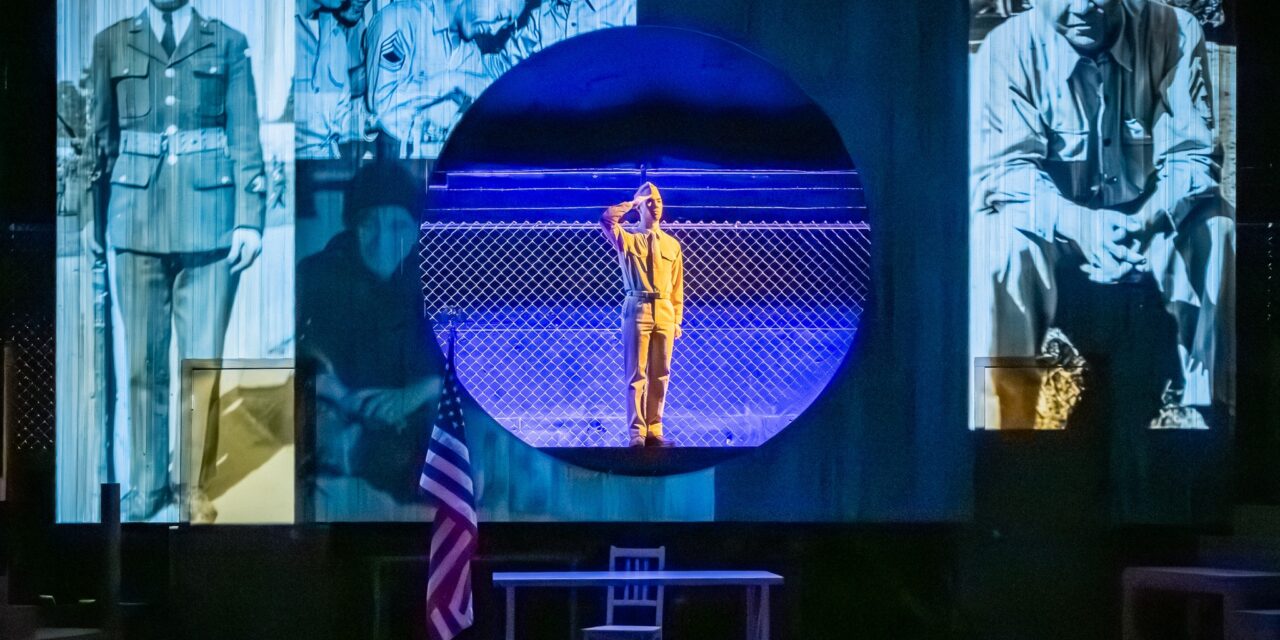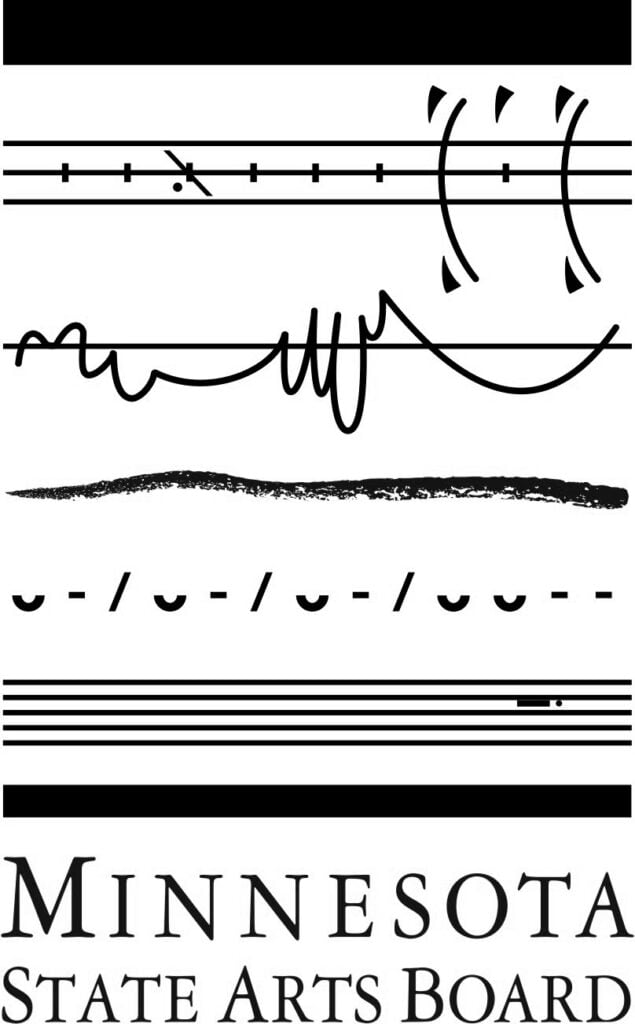Quote of the Day: The forced eviction and confinement of Japanese Americans after Pearl Harbor in 1941 was one of the worst civil rights violations of the twentieth century, and the repercussions were numerous. The effect in Minnesota was dramatic: only fifty-one Japanese American people lived in the state in 1940, but by war’s end there were several thousand. from the description of the book Enmity and Empathy by Ka F. Wong (MN Historical Society Press).
I’m calling this post a “Review and Reflections” because I saw Secret Warriors at the end of its run at the History Theatre. It closed on Saturday, April 19. As I was standing in the lobby, waiting for the house to open, I noticed a large family group assembling on the stairs. A woman came up to me and asked if I’d take their picture. I took several as they were a large group and it seemed that someone was missing and they were waiting for everyone to gather. I asked the woman if she had a connection to someone in the story. “Yes,” she said, “My father was one of the men who were part of the group who are featured in this play.” The person I met was Karen Tanaka Lucas who is listed in the playbill as Japanese American Cultural Consultant. She went on to tell me a little about her father, his involvement, and pointed out pictures on display that he’s in. I asked if he talked about his experiences in the war. She said, “No,” they didn’t know anything about it because it was Military Intelligence, and Top Secret. It wasn’t until the 2000’s that they released the information about their missions and service. She pointed out the picture of her father receiving the gold medal for his services when he was 94 years old. A long time to wait, she said, but he lived to experience it. He died shortly after that.

Paul LaNave, Josh Kwon, Erik Ohno Dagoberg, Song Kim, and Clay Man Soo in Secret Warriors at the History Theatre, thru 4/19/25. Photo: Rick Spaulding
Secret Warriors by MN playwright R. A. Shiomi is about the Japanese American involvement during World War II that was vital for information, interrogation, and connection to the Japanese theater. The men who were recruited for this mission were Nisei, second-generation Japanese-American citizens, and they had some knowledge of the Japanese language. They were sent to a Japanese language emersion school at Camp Savage in Minnesota for their training. Shiomi’s play features four soldiers who represent those who were on this special mission for the United States of America. As they were serving their country, their families were in Internment Camps in the United States because the US government leaders feared that they were a threat to national security because they had Japanese heritage.
The play is so well constructed by playwright Rick Shiomi and directed by Lily Tung Crystal. They tell the story through the eyes of four Japanese American soldiers: Tamio (Erik Ohno Dagoberg), Masa (Song Kim), Isamu, or Sam, (Josh Kwon), and Koji (Clay Man Soo). They meet at Camp Savage and quickly form a bond of friendship, both teasing and challenging each other and helping each other get through and pass the course work. We learn about their families and all that they lost when they were sent to Internment Camps. They go to a USO dance where a couple of them meet women that they fall in love with and exchange letters and stories. Kendall Kent plays Denise who falls in love with Tamio, getting engaged right before he is deployed. Stephanie Anne Bertumen plays Natsuko who corresponds with Koji. Letters from family, friends, and sweethearts were vital in keeping up the moral of the soldiers. (Watch the Netflix film Six Triple Eight to see the tremendous task of sorting and delivering the mail during WWII by the all-Black all-female battalion.)
Of course, there was pushback and horrible racism against these soldiers, but there were also people who supported them and realized the valuable contribution they had to the success of the war effort. Paul LaNave plays Lt. Jeff Nelson who pushes the young men, but also shows them respect and encouragement. He and Tony Larkin also play other characters who are White, representing soldiers who did not support the Japanese American troupes. In fact, they saw them as the enemy. Rich Remedios plays John Aiso, Japanese instructor at Camp Savage. He also plays a Japanese Captain who is interrogated by Koji during the end of the war.

Erik Ohno Dagoberg, Clay Man Soo, Tony Larkin, Stephanie Anne Bertumen, and Kendall Kent in Secret Warriors at the History Theatre, thru 4/19/25. Photo: Rick Spaulding
The stage and set (designed by Erik Paulson) easily lends itself to the multiple locations in this play. With elevated areas on both sides of the stage for scenes on ship decks, overlooks, and outdoors of the dance hall to a center raised platform at the back where an actor could stand in a circle to talk about their story. Lighting and sound cues also gave clarity to time and place, (Lighting: Wu Chen Khoo, Sound: Frederick Kennedy). Wonderful period costumes by Meghan Kent. The use of video and projections also highlighted the events of this time period (designed by Kathy Maxwell).
Everything worked together beautifully to create this important and moving production of Secret Warriors. It was on my must-see list for this Spring, and I’m so glad that I made it to this performance. What a fortuitous opportunity to meet Karen Tanaka Lucas and photograph her family. They are so proud of their father/grandfather and his contributions to the war. I have to admit that when I was growing up, I don’t remember hearing much about the Internment Camps, maybe a mention. So, when I was at the Smithsonian History Museum when I was in my 20’s, I was stunned by the exhibit of people living in camps – in the United States of America! What, I thought, where is this? I stood there a long time, reading about what happened to these people and feeling a profound sadness. Watching this play gave me more insight into what my fellow Americans had to endure and also what they contributed to our freedoms. We are the United States of America – a melting pot, as we were taught in school. People of various backgrounds and heritage forming a new world and building community, understanding and respecting different cultural practices and beliefs while maintaining a love for our own and where we came from.

Secret Warriors at the History Theatre, thru 4/19/25. Photo: Rick Spaulding
Thank you, Karen, for sharing your families’ story and inviting me into it. Thank you, Rick Shiomi for seeing the value in it and bringing it to life through your writing. Thank you, Lily Tung Crystal for giving this play such fine direction and really bringing out the nuance, heart, and challenges of these characters. Thank you, always, those who make decisions at the History Theatre for finding such poignant and relevant stories that encompass not only Minnesota history, but also United States history, and global significance. I hope this play finds its way onto other stages around the world.
Go to the History Theatre’s website to see what’s coming up in this season and next. Support the arts and storytellers of all backgrounds and perspectives. It’s a great way to fight tyranny and exclusion.
Go. Create. Inspire!
Journaling Prompt: What do you know about the Japanese American involvement in World War II?












Recent Comments